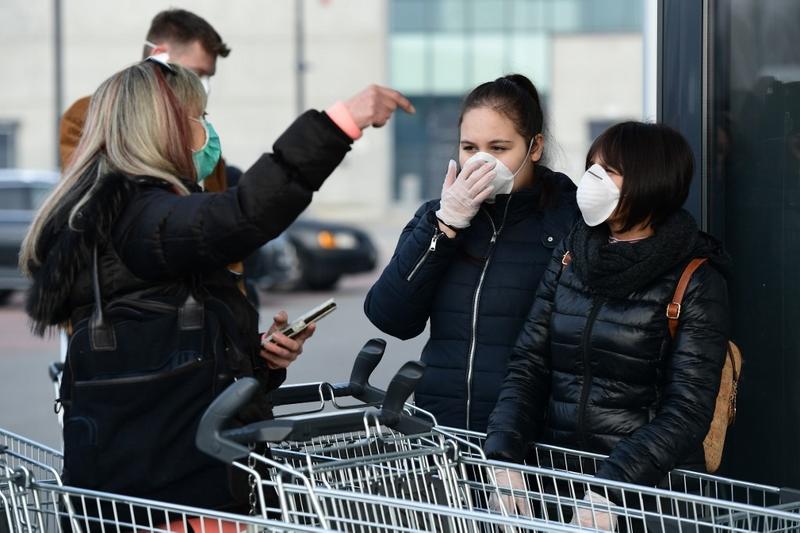 Residents wearing respiratory mask wait to be given access to shop in a supermarket in small groups of forty people on Feb 23, 2020 in the small Italian town of Casalpusterlengo, under the shadow of a new coronavirus outbreak. (MIGUEL MEDINA / AFP)
Residents wearing respiratory mask wait to be given access to shop in a supermarket in small groups of forty people on Feb 23, 2020 in the small Italian town of Casalpusterlengo, under the shadow of a new coronavirus outbreak. (MIGUEL MEDINA / AFP)
The number of coronavirus cases continued to jump in the north of Italy even after the government imposed a lockdown and banned travel to and from an area near Milan of about 50,000 people.
The number of cases in the Lombardy region jumped overnight to 89 from 54, leaving the country with more than 100 confirmed infections, about five times that of Germany, the European country second in the ranking. Two people have died in Italy from the virus, the first non-tourist deaths in Europe.
The rapid number of new cases in less than a week and Italy’s inability to stem the spread from a hospitalized patient is fueling fears of broader contagion
Prime Minister Giuseppe Conte late Saturday announced the travel ban and other emergency measures in response to the surge in cases that have occurred since a man sought medical treatment at a hospital in Lombardy on Feb 18.
He is believed to have infected dozens of patients and medical staff who then carried the virus further afield.
“When doctors are infected, that means the right practices were not put into place, apart from the fact that the virus is very contagious,” Walter Ricciardi, a member of the executive council of the World Health Organization, told newspaper La Stampa.
READ MORE: Italy reports 1st death as US prepares for coronavirus pandemic
Ricciardi also criticized the government for banning flights to and from China, saying that stopped authorities from tracing arrivals as travelers could use stopovers to reach Italy.
Italy won’t seek a suspension of the Schengen agreement, which has eliminated border controls between 26 European countries. Even so, the virus surge illustrates the potential threat to borderless travel and commerce in Europe, which last came under pressure during the continent’s refugee crisis in 2015-16.
The rapid number of new cases in less than a week and Italy’s inability to stem the spread from a hospitalized patient is fueling fears of broader contagion. Italy has implemented emergency measures in towns along its frontier with Slovenia.
French Heath Minister Olivier Veran told Le Parisien Dimanche newspaper that “it’s very likely” the country will now face new cases and laboratories are being supplied with additional test kits.
Italy asked other major economies to “work immediately on economic measures at an international level that are coordinated and sufficient to deal with the economic consequences of the virus in a timely and effective way in case the crisis worsens,” Finance Minister Roberto Gualtieri said on the sidelines of a Group of 20 meeting in Riyadh.
ALSO READ: Scientist from Italy plans to stay in Wuhan
Italy’s government also plans to introduce measures to support the economy in virus-affected areas, Conte told reporters in Rome.
All work activities, public events and schools will be canceled or closed in the affected area around Lodi, a town about 50 kilometers southeast of Italy’s financial hub. Conte suggested residents may have to endure the restrictions for several weeks, though he didn’t specify a timeline.
Attilio Fontana, the president of Lombardy, called for schools also to be closed in the city of Milan.
Authorities also closed some universities and canceled public sports events Sunday in the northern regions of Veneto and Lombardy, including Serie A soccer games Inter Milan-Sampdoria, Atalanta-Sassuolo and Verona-Cagliari. Those northern regions are among five reporting coronavirus cases in Italy.


